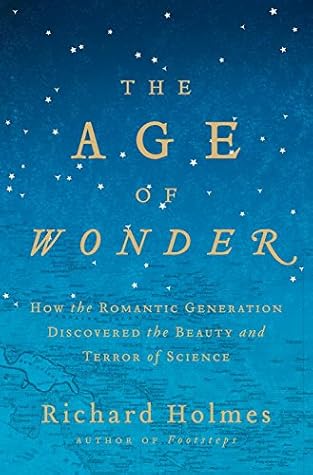More on this book
Community
Kindle Notes & Highlights
Read between
September 24 - November 9, 2020
Romantic science can be dated roughly, and certainly symbolically, between two celebrated voyages of exploration. These were Captain James Cook’s first round-the-world expedition aboard the Endeavour, begun in 1768, and Charles Darwin’s voyage to the Galapagos islands aboard the Beagle, begun in 1831. This is
the time I have called the Age of Wonder, and with any luck we have not yet quite outgrown it.
The idea of the exploratory voyage, often lonely and perilous, is in one form or another a central and defini...
This highlight has been truncated due to consecutive passage length restrictions.
First, the dazzling idea of the solitary scientific ‘genius’, thirsting and reckless for knowledge, for its own sake and perhaps at any cost.
idea of the ‘Eureka moment’, the intuitive inspired instant of invention or discovery, for which no amount of preparation or preliminary analysis can really prepare.
Romantic science would seek to identify such moments of singular, almost mystical vision in its own history.
The notion of an infinite, mysterious Nature, waiting to be discovered or seduced into revealing all her secrets, was widely held.
softer ‘dynamic’ science of invisible powers and mysterious energies, of fluidity and transformations, of growth and organic change.
The ideal of a pure, ‘disinterested’ science, independent of political ideology and even religious doctrine, also began slowly to emerge.
whether it could be an instrument of the state, in the case of inventing weapons of war. Or a handmaiden of the Church, supporting the widely held view of ‘Natural theology’, in which science reveals evidence of a divine Creation or intelligent design.
Romantic science, on the other hand, had a new commitment to explain, to educate, to communicate to a general public.
introductory textbook, often written by women.
challenged the elite monopoly of the Royal Society, and saw the foundation of scores of new scientific institutions, mechanics institutes and ‘philosophical’ societies,
whether Romantic science contained terror as well as wonder: if discovery and invention brought new dread as well as new hope into the world.
This book is centred on two scientific lives, those of the astronomer William Herschel and the chemist Humphry Davy.
‘When we try to recognise the idea inherent in a phenomenon we are confused by the fact that it frequently — even normally — contradicts our senses. The Copernican system is based on an idea which was hard to grasp; even now it contradicts our senses every day [that the sun rises] … The metamorphosis of plants contradicts our senses in this way.’
combustion, respiration, oxidation.
precise experiment, close observation and accurate measurement. Above
experimental science as a great Romantic adventure of the mind.
poetry surrounding the light of science.
All mental problems — including pain and unhappiness — might be cured by the chemistry of drugs and gases.42
He spread his initial experiments over various compounds of ‘factitious airs’, including hydrogen, carbon dioxide and carbon monoxide, and several combinations of nitrous gas. Before trying anything out on his patients, he tested everything on himself, often at grave risk. Fainting fits, nausea and stunning migraines frequently overcame him. But he was undaunted.
I said to myself I was born to benefit the world by my great talents.’58
Davy now pioneered the ‘blind’ experimental method. He deliberately did not tell his subjects what concentration of nitrous oxide they were breathing, or whether they were in fact inhaling ordinary air (which they sometimes were).
Davy now conceived a new and original line of investigation. He began to enlist perfectly healthy subjects, chosen from his highly articulate circle of Bristol friends, and asked them to describe their sensations as precisely as possible.
Poetry, he argued, would
He must have compared the gas with his already extensive and overpowering experience of opium.
He thought that science, as a human activity, ‘being necessarily performed with the passion of Hope, it was poetical’. Science, like poetry, was not merely ‘progressive’. It directed a particular kind of moral energy and imaginative longing into the future. It enshrined the implicit belief that mankind could achieve a better, happier world. This is what Davy believed too, and ‘Hope’ became one of his watchwords.
Deeply and intimately connected are all our ideas of motion and life,
and this, probably, from very early association. How different is the idea of life in a physiologist and a poet!’
linked to the craze for ballooning.
general link between radical politics, inhaling gas, flying balloons and mesmerism.
the ‘hopeful’ and progressive nature of science,
the new poetry and the new science were so closely entwined that they must somehow merge,
the progressive role of science in society.
200 amputations in twenty-four hours after the battle of Borodino, and
Blumenbach introduced the first classic racial divisions between
Caucasian, African, Asiatic and Indian types.
the dominion of religion over the arts and sciences.
the hopes and ambitions of Romantic science to produce a better world for all mankind.
united the worlds of literature, science and high society.
facts are preserved which suit the temper or party of a particular historian.’
relating the human predicament to the scientific solution,
applied science could be a force for good previously unparalleled in human society, and might gradually liberate mankind from untold misery and suffering.
‘A struggle almost equal to an Earthquake must take place & Slavery must be abolished not on moral principles, which are in my opinion incapable of being maintained in argument, but on Commercial ones which weigh equally in moral & immoral minds.’19
‘The Progress of Science … is to destroy Wonder, and in its stead substitute Mensuration and Numeration.’
Science was a gift of God or Providence to mankind, and its purpose was to reveal the wonders of His design.
science versus religion, science versus the arts, science versus traditional ethics — are no longer enough.


